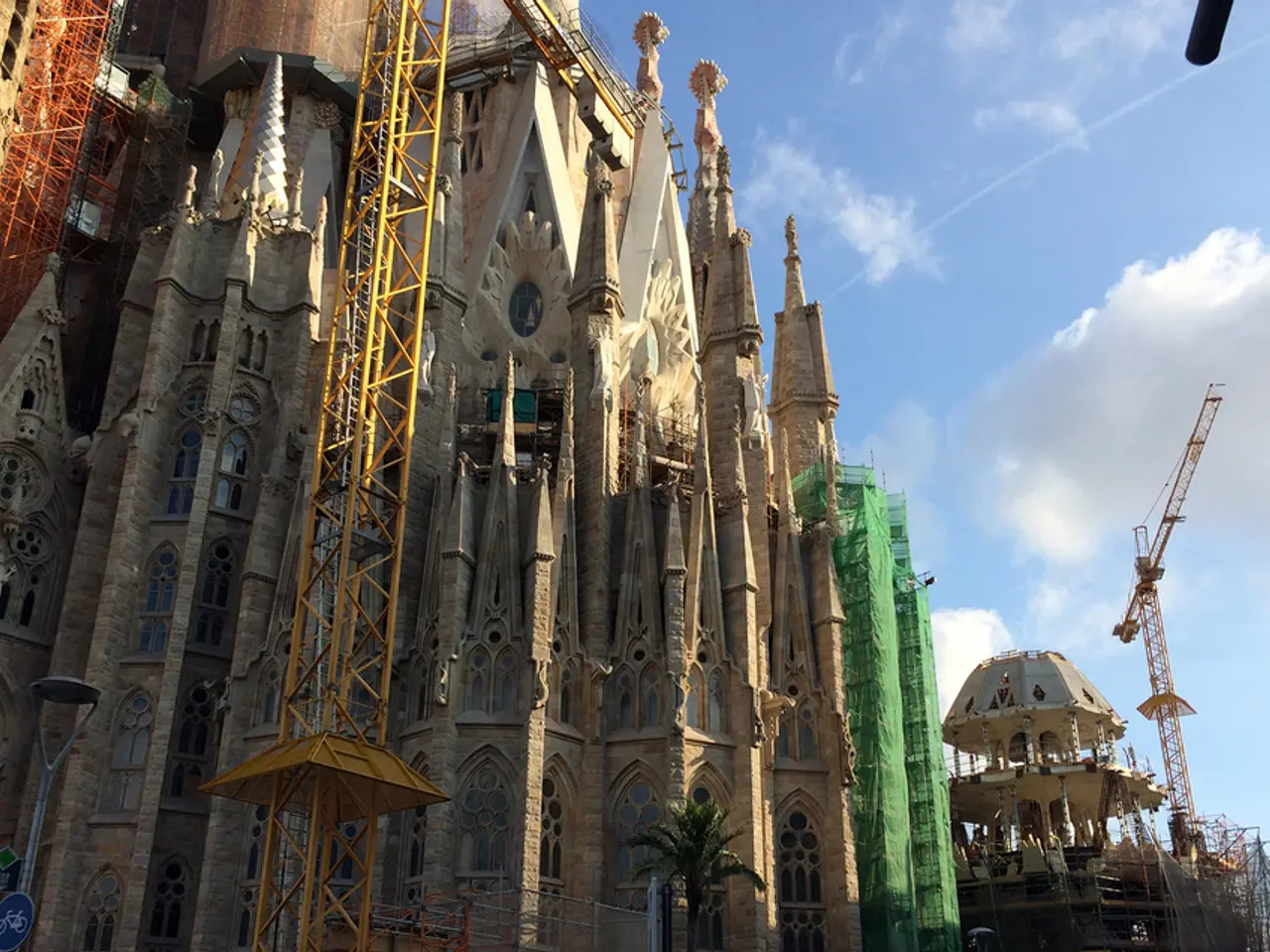Enhancement of Construction Sector by Augmented Reality
Unleash the potential of digital overlays right in your construction site with these mind-blowing benefits of using AR technology in the heart of your projects! From improved design and visualization, enhanced collaboration, to reduced on-site errors, AR empowers your team to work smarter, faster, and safer.
Take a Deeper Dive into AR Advantages
witnessed the dawn of digital overlays transforming industries across the globe, especially construction. Here's what you can expect when you incorporate this technology into your construction site:
1. Mind-blowing design and visualization
Say goodbye to flat 2D blueprints! Augmented Reality (AR) revolutionizes your design and visualization process by turning your static 2D blueprints into interactive 3D models. Experience the magic as digital models merge with the real construction site to let everyone visualize what the endgame will be. This game-changing visualization helps reduce misunderstandings and costly design changes down the line.
2. Seamless collaboration among dream teams!
Think of AR as your secret collaboration weapon. It makes collaboration a cinch by providing real-time project updates, instantaneously linking team members across diverse locations, and allowing sharing of the same project data. That way, design and project managers can pinpoint potential design glitches and prevent design-related errors before they reach the site. Collaborative harmony, anyone?
3. Farewell to costly errors and rework!
By using AR to overlay Building Information Modeling (BIM) data during on-site verification, construction teams can easily spot and correct errors, drastically reducing costly rework. Imagine boosting project efficiency and eliminating errors with this future-focused tech!
AR in Action: Practical Applications
AR's unparalleled benefits extend beyond major construction milestones. Here are a few examples of just how versatile AR can be in your construction projects:
1. Simplified assembly and installations
Complex installations of MEP (Mechanical, Electrical, and Plumbing) systems, for instance, are a piece of cake with AR. Technicians can follow digital guides displayed through AR headsets, enabling real-time adjustments and guaranteeing each component fits perfectly.
2. Increased safety and better training procedures
Forged in safety, AR simulations mimic dangerous scenarios in a controlled setting, helping newbies avoid potential hazards. AR-based training enables teammates to familiarize themselves with equipment and procedures before stepping into high-risk construction zones.
3. Efficient maintenance and facility management
Fast-forward to a completed project, AR aids facility managers by visualizing digital maintenance records, specifications, and real-time data for building systems. Now that's what we call a handy digital tool for informed decision-making during maintenance tasks!
4. Engaging customers with immersive, experiential marketing
Giving a sneak peek to your customers is no longer a dream thanks to AR technology. By creating immersive walkthroughs of a project before it's actualized, you can improve customer connections and foster trust during the design and sales phases.
Navigating Potential Issues When Embracing AR
While AR promises a brighter, more efficient future for construction, it's crucial to tackle some technical and financial challenges before jumping in headfirst. Here's what you need to be aware of:
1. High costs of AR technology**
Incorporating AR solutions might prove burdensome, particularly for smaller companies, as high-end AR headsets and software demand significant investments. Comparing the cost to potential benefits, you have to weigh the scales wisely to decide if adopting AR technology is worth it.
2. Data lattice, anyone? Integrating AR systems with current software
Hooking up AR systems with existing project management and BIM software is essential for a smooth operation. However, the compatibility challenge persists as not all AR solutions work hand in hand with popular BIM platforms. To ensure seamless workflows, choices must be made carefully.
3. When safety meets technology
Safety concerns crop up when construction workers wear AR headsets making them less mindful of their surroundings, potentially leading to increased accidents. Developing safety guidelines and training workers to handle AR without compromising their awareness of on-site hazards is essential for minimizing risks as you embrace this new tech on your site.
4. Crafting a virtually connected construction world
Numerous construction sites grapple with connectivity issues, specifically in remote and densely built-up areas where an uninterrupted internet connection is hard to come by. Since AR relies on real-time data, unreliable connectivity can significantly limit the effective utilization of AR devices and solutions.
The Dawn of an Augmented Future in Construction
As AR technology further evolves, costs will decrease, and AR will become accessible to smaller construction firms. Future advancements in AR devices will result in improved sensors, greater accuracy, and exceptional integration with BIM and project management platforms, ensuring streamlined workflows. Supercharged mobile AR technologies are also on the horizon, bringing real-time, 3D visualization to construction sites without the need for specialized hardware.
The future of AR in construction sparkles even brightly across a range of industries, including safety, healthcare, real estate, education, and more. Are you ready to take the construction world by storm with immersive experiences tailored to revolutionize your projects?
Harness Augmented Reality's Power for Your Construction Projects
Looking for an ace in the hole to amplify your construction projects? Proven Reality has got you covered! Our skilled team creates imaginative AR, VR, and MR applications to elevate your construction processes, simplify workflows, and enhance site safety through cutting-edge immersive experiences.
Follow the links to learn more about our game-changing solutions. Let's step into the future of construction together and build a better, safer tomorrow for everyone!
Visit Proven Reality and explore how AR can transform your industry today!
References:
[1] MarketsandMarkets (2021). Augmented Reality (AR) in Construction Market by Component, Technology, Application, End-Use Industry, and Region – Global Forecast to 2026. Retrieved from https://www.marketsandmarkets.com/Market-Reports/augmented-reality-ar-in-construction-market-990.html
[2] AEC Magazine (2019). Augmented Reality Offers Opportunities for AEC Industry. Retrieved from https://www.aecm.com/aec-magazine/technology/augmented-reality-offers-opportunities-for-aec-industry/
[3] International Data Corporation (IDC) (2020). Worldwide Semiannual Augmented Reality Spending Guide. Retrieved from https://www.idc.com/promo/worldwide-augmented-reality-spending-guide/
[4] Baumbach, J., & Morin, A. (2018). Augmented Reality in the Construction Industry: Benefits, Challenges, and Future Research Directions. Journal of Construction Planning and Management, 34(2), 137–149. doi:10.1061/(asce)cp.1943-0847.0001024
[5] Construction Executive (2018). Augmented Reality in Construction: The No-Nonsense Guide for Contractors. Retrieved from https://www.constructionexecutive.com/resources/whitepapers/augmented-reality-in-construction-the-nononsense-guide-for-contractors/
[6] Grand View Research (2019). Augmented Reality (AR) in Construction Market Size, Share & Trends Analysis Report by Component (Hardware, Software, and Services), By Application (Design, Visualization, and Inspection), Regional Outlook, Competitive Landscape and Segment Forecasts, 2020 – 2026. Retrieved from https://www.grandviewresearch.com/industry-analysis/augmented-reality-ar-in-construction-market
- The integration of AR technology in construction projects revolutionizes design and visualization, turning static 2D blueprints into interactive 3D models, thereby reducing misunderstandings and costly design changes.
- AR technology empowers collaborative harmony in construction projects by providing real-time project updates, instantaneously linking team members across diverse locations, and allowing the sharing of the same project data.
- By using AR to overlay Building Information Modeling (BIM) data during on-site verification, construction teams can easily spot and correct errors, drastically reducing costly rework.
- AR simplifies complex installations of MEP (Mechanical, Electrical, and Plumbing) systems, as technicians can follow digital guides displayed through AR headsets, enabling real-time adjustments and guaranteeing each component fits perfectly.
- AR increases safety and improves training procedures in construction by imitating dangerous scenarios in a controlled setting, helping newbies avoid potential hazards and familiarize themselves with equipment and procedures.
- AR technology aids facility managers in visualizing digital maintenance records, specifications, and real-time data for building systems, enhancing informed decision-making during maintenance tasks.




